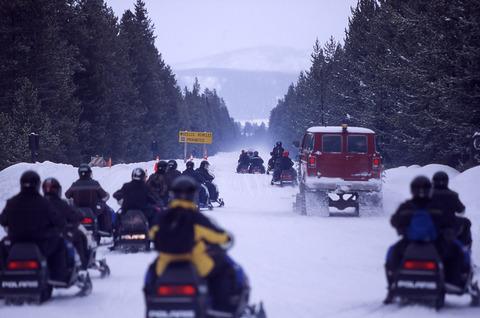Perplexing. That's my initial reaction to the Environmental Protection Agency's response to the snowmobile decision out of Yellowstone National Park.
In five short paragraphs the EPA officials went from seemingly complimenting the decision to saying park planners failed to fully address their concerns.
The letter, from Larry Svoboda, director of EPA Region 8’s National Environmental Policy Act program, is the EPA's formal response to Yellowstone's preferred alternative. It pales in comparison to the length and detail of the letter the agency sent when it commented on the park's draft Environmental Impact Statement.
In that letter, the EPA said the preferred alternative, to allow 720 snowmobiles a day into the park, would be much more polluting than a plan to phase-out snowmobiles in favor of snow coaches. Too, that letter pointed out several areas where the preferred alternative would run counter to the Park Service's own Management Policies.
Granted, Yellowstone's planners have scaled back the number of snowmobiles that would be allowed into the park to 540. But the EPA in its most recent letter doesn't specify whether that would satisfactorily address its previous concerns, even though in that earlier letter the agency said allowing more than 250 snowmobiles per day into the park could compromise human health.
In its latest letter, EPA says the 540-snowmobile-option would reduce pollution levels when compared to "historic conditions," but is oddly silent, in light of its previous stance, on which option for over-snow-travel would be most beneficial for Yellowstone's resources, wildlife, visitors and employees.
Historic use, by the way, stems from snowmobile traffic levels in the 1990s, when as many as 1400 snowmobiles would enter the park on a daily basis. Those machines were powered mostly, if not entirely, by 2-stroke engines, which are far more polluting than the 4-stroke models now entering the market. So to say the proposed 540-snowmobile alternative improves conditions when compared to those of the 1990s is not a stretch, but does not place it in context relative to the 250-per-day average seen the past three winters nor the snow coach-only option.
(If you want to delve deeper into the comparative emissions data, check out this document from Yellowstone. It not only compares historic emission levels to more recent levels, but it also explains how winter inversions can tremendously boost pollution levels and that pollution created by snowmobiles exceeds that created during the summer months by cars, trucks and buses.)
Now, back to EPA's letter. Here are the two seemingly contradictory paragraphs from that letter:
EPA acknowledges the improvements gained in the Parks’ winter environment compared to historic conditions. The NPS’s preferred alternative identified in the Final EIS incorporates best available technology (BAT) for all over-snow vehicles and requires full commercial guiding. EPA supports the NPS’s commitment to the BAT program which reduces vehicle emissions and noise compared to conditions that existed historically. We also agree with this Final EIS that full commercial guiding is critical to protecting resources and visitor experiences under any alternative.
On June 13, 2007, EPA provided comments on the Draft EIS. EPA is concerned that a number of these comments are not fully addressed in the Final EIS. Specifically, the Final EIS is not entirely responsive to EPA’s concerns regarding adaptive management, desired conditions, the effects of air quality and noise on visitor experience, available mitigation for natural soundscapes, and unsupported statements on snowcoach impacts. We trust that NPS will consider addressing these remaining concerns as you prepare the Record of Decision and Final Rule for this action.
Reading between the lines, the EPA seems only to be saying that Yellowstone planners are right in demanding that "best available technology" be required on snowmobiles and snow coaches and that guides are a good idea, too. Why the agency wasn't as thorough in both analyzing the preferred alternative and pointing to its weaknesses as it was in critiquing the draft alternative earlier this year is a mystery. Cynics, I'm sure, would suggest politics intruded.
I've requested some clarity from the EPA on its latest position, and will pass it on once I receive it.




Comments
In my work environment - I'm in a job where we send reviews of state education standards to the states - we generally don't send reviews that are as detailed the second time around as the first time around, deferring to earlier reports. Generally, the final review is in the form of a short letter, much like the short letter we see here from EPA to NPS. However, this last letter often carries more political punch to it than the previous review - because: 1) it's final; 2) high level policy makers are more likely to read it. (That is part of the reason the letter is so brief).
I have a hunch that NPS won't receive this letter from EPA very well and that EPA meant it to be damning, but couched in the polite prose typical of such letters. When we are critical, we still always, always, always acknowledge what the state has done well and the ways it has responded positively to what we've previously stated. However, inevitably, states will always be focused on anything that's negative. Here, the bottom line is that EPA is not happy. This is very harsh, almost snide language.
Behind the scenes of this, there was no doubt some communication. If this is the final letter that's been produced, then NPS can't possibly be happy with it. It's too late for EPA to make adjustments to it. That means we're looking at some hardball and the basis for yet another lawsuit (unless NPS makes more changes that it doesn't want to make).
Jim Macdonald
The Magic of Yellowstone
Yellowstone Newspaper
Jim's Eclectic World